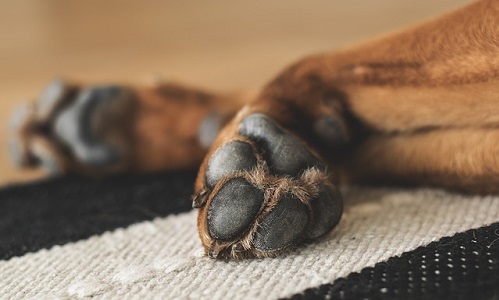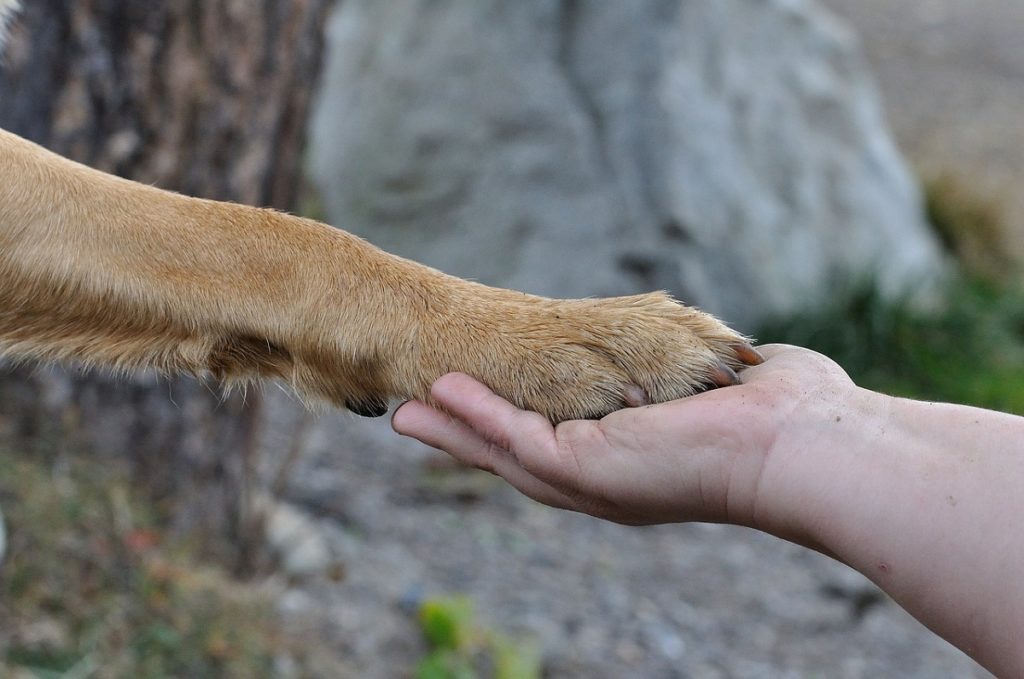Man’s best friend has some enviable traits – that legendary sense of smell, for example – and one of the most interesting canine features is found at the end of their legs. Dog paw pads are a versatile adaption to the environments frequented by their furry predecessors. Equal parts temperature and terrain sensor, traction tread, heat exhaust, anxiety sink, and shock absorber, these unassuming bits of canine anatomy serve an incredible amount of functions for your four-footed companion, which means that injuries to them must be taken very seriously, even if they appear small at first. This article will cover what you need to know as a pet owner, including how dog’s paw pad protection techniques, treating scrapes, burns and abrasions, preventative measures to safeguard him from injuries, and other helpful tips.
The Anatomy Of Your Dog’s Paw Pads
There are five parts to your pup’s pads, and knowing their structure is important for communicating with your vet in a paw pad injury situation.
- Claws: while dogs can’t flex and retract their claws outwards the way their feline counterparts do, claws are still one of the most useful tools a dog has. They can be used to dig in the dirt, injure enemies, and offer traction in slippery terrain; they also help your pooch hold onto prey, food, or toys.
Made of a hard fingernail-like substance called keratin, these nails have an inner core with nerve endings and blood vessels inside, called the quick. Great care must be taken when trimming a dog’s nails, as cutting into the quick by mistake can cause your dog pain, shock, and distrust in your intentions. For the best results and the cleanest cut, either trust your dog to a professional or use a guillotine-style cutter rather than a flat nail clipper, which may cause nail splintering or jagged edges.
- Digital Pads: These are roughly equivalent to human finger pads and take the brunt of a dog’s weight while out for a walk. Because they are the first part to contact the ground during a stroll, they’re also an excellent indicator of how your pooch is faring – too hot, and they need to cool down. Too rough and/or cracked, and you might need to stick to soft, grassy areas for a while until they heal.
- Metacarpal Pads: This is the large “central” pad that looks a little like a cartoon nose when viewed at a certain angle. This cushion takes a lot of the stress of a doggie stride and allows it to bounce back and keep walking or playing.
- Dewclaw: Scientists believe that canine dew claws are the leftover remnants of what may have once been thumbs! While they don’t serve much active purpose for most dogs today, they can unfortunately get snagged and torn in canine mishaps, so it’s important to examine them if your dog is showing signs of paw injury.
- Carpal Pad: Think of the carpal pad – a small circle that sits on the highest back portion of the paw and lower leg – as being a little like emergency brakes. If the dog is traveling in slippery or steep conditions, it gives them an added boost of traction to keep their footing secure.
 Did You Know…
Did You Know…
No Sweat! Your dog also sweats from their paw pads, believe it or not. That’s why, as adorable as doggie shoes are, they shouldn’t be worn for extended periods of time – it would be like humans wearing sneakers but never socks, as it would chafe and sweat would accumulate uncomfortably. Pads can also sweat when the dog is nervous or anxious, just as we would get clammy hands in a stressful situation like a job interview. Some dogs even habitually chew at their paw pads the way we might bite our fingernails!
Paw Pad Condition Varies
There is no “optimal” condition for a dog paw in terms of roughness or smoothness. Just as the soles of various human feet will vary widely depending on the way they live (and the terrain the person walks upon), dog paws will always reflect their environment, since they naturally walk “barefoot” everywhere they go. If your pup has rough, callused paw pads but spends a lot of time outdoors or out on hikes with you, there’s no need for alarm! He is simply building up what is essentially a pair of shoes to contend with uneven, grainy, or rocky terrain without hurting the padded layer of fat and blood vessels that are present in paw pads. Likewise, if your dog’s sporting smooth, callus-free paws, it probably just means that they see far more carpet and linoleum than dirt and sand.
While calluses can provide a lot of protection over time, it’s important to remember they aren’t shoes. From an evolutionary standpoint, human creations like asphalt, concrete, and glass are very new inventions and hold far more heat and cold than natural materials normally would. This can equal bad news for a dog out on a walk in extreme conditions, as even the most callused pads can’t insulate against prolonged direct contact with high or low temperatures. A good rule of thumb is that if you can’t put your bare hand comfortably on the walking surface for more than a few seconds, it’s a danger for your dog and you should avoid walking them in that area. Below are a few commonly-asked questions addressing paw pad injuries and general care:
Q: What should I do for dog paw pad freezes and burns?
A: Even if you’re careful to avoid walking your dog on dangerous surfaces, some pups tend to get into trouble and take “unauthorized” strolls where they shouldn’t. If this happens and your dog comes home with red paw pads, blistered, or swollen, it’s important to act right away. First, comfort your dog and gently inspect his paws visually – is the damage uniform across all four paws? This is one of the best ways to make sure that it was a surface that injured your dog, and not an environmental aspect (e.g., broken glass, chemical exposure, or an insect sting). If it’s a serious injury, your dog will be limping, whining, and avoiding putting weight on their paws.
If it does look like temperature is the culprit, get a bowl of room-temperature water to soak your pup’s paw pads while you hold them. Keep a tube of dog-safe antibiotic ointment and soft gauze in the house, and soak his paw; dry the area, apply ointment, and loosely bandage your dog’s injured paws if necessary. Isolate them from triggers that may cause them to become hyperactive (such as other pets or someone knocking at the front door) – they’ll be more likely to relax and stay off their pads so they can heal. If the pads still look red and/or swollen after a day or two when you remove the bandages, take your dog to the vet for further examination and treatment.
In the winter, be aware that cold temperatures aren’t the only danger to your pup’s paws: the ASPCA recommends a thin coating of petroleum jelly over the paw pads before walking in wintery conditions. The American Kennel Club even has a handy recipe for making your own paw balm!
Salt and ice-melting chemicals can also harm your dog’s paws – and digestion, if they attempt to lick it off. Add a thin layer of the jelly before the walk and wash or wipe their pads in room temperature water before letting them back inside: this will minimize exposure to ice-melting chemicals.
Q: What should I do for dog paw pad cuts and scrapes?
A: It’s a scary moment in a dog parent’s life when they realize their beloved pup is tracking blood behind them. The first step is to get your dog off their paws so you can get a close look at them – don’t hesitate to “bribe” them with treats and belly rubs so their paws are up. Gently grasp their leg at the ankle (or closer to the body to avoid accidentally hurting them further), and manipulate the leg to get the paw pad in good lighting. If there are any foreign objects embedded in the paw pad, swaddle your pup in a blanket or towel to prevent thrashing, and use a pair of tweezers to quickly remove the offending item.
Just as with human wounds, hold a clean, absorbent cloth to any wounds that are openly bleeding to stop the flow of blood. If the wound hasn’t stopped seriously bleeding within 15 minutes, take your dog to the vet immediately for assessment. If the wound does stop bleeding, carefully clean the pad by dabbing with a paper towel or cloth soaked in room-temperature water, following up with antibiotic ointment and a clean gauze/vet wrap (a type of non-sticky ace bandage made for animals) combination. This dressing should be replaced frequently until your dog’s paw pad wound is closed and visibly healed, and they’re no longer hesitating to put weight on it.
Q: What should I do for dog paw pad tears and punctures?
A: Sometimes, more serious injuries are inflicted to dog paw pads – the American Veterinary Medical Association cautions that they may get ‘road rash’ from a fast trip down a steep embankment or run across an area with gravel or broken glass on the ground. If your dog’s paw pads look like they have been punctured or the pad itself is torn, it’s important to seek out medical help as soon as possible. A clean healing period will make all the difference in your dog’s quality of life after a pad tear, and pads can be very difficult to reconstruct through bandaging at home. Even at the vet, it’s likely that staples and stitches won’t be used because pads are notoriously resistant to these measures.
Good Paw Pad Practices: Staying Proactive
As a pet parent, there are many things you can do proactively – not just in a first-aid type of situation – to safeguard the health of your dog’s paw pads. Massaging is one of the best ways to keep the paw pads healthy and resilient, with the added bonus of your dog’s adoration. When you’re spending time with them on the couch, gently rub their paw pads in between belly rubs and it will have the same soothing effect as a hand or foot massage would have for you. In the summer and winter, pad skin can become chapped and split the same way our skin might in dry weather, so invest in a protective, dog-safe balm to help keep their pads moisturized as well.
 In the spring and summer, if you notice your dog chewing or licking at their paw pads a great deal, be sure to talk with your vet about potential allergens. Dogs can get hay fever or plant sensitivities, and sometimes the canine version of an antihistamine might be necessary to keep them from ‘worrying’ at their paws whenever they come in for the day. Stressful situations and dog anxiety can also cause this compulsive paw biting and licking, so if you don’t think the environment is causing the behavior, give your pup a little extra love and companionship to help them cope without self-injuring.
In the spring and summer, if you notice your dog chewing or licking at their paw pads a great deal, be sure to talk with your vet about potential allergens. Dogs can get hay fever or plant sensitivities, and sometimes the canine version of an antihistamine might be necessary to keep them from ‘worrying’ at their paws whenever they come in for the day. Stressful situations and dog anxiety can also cause this compulsive paw biting and licking, so if you don’t think the environment is causing the behavior, give your pup a little extra love and companionship to help them cope without self-injuring.
While snowshoes and rain boots might make for some great social media pictures, make sure the design you choose is the right fit for your dog so you aren’t causing more harm than good. In some situations, like prolonged hikes, they aren’t a bad idea, but for the most part, Mother Nature has done an adequate job preparing your pooch for exposure to temperate elements. If you do intend to introduce your furry companion to a new set of shoes for the sake of a healing paw, be sure to put them on indoors for awhile to let them get acclimated. Dogs are known to run and jump erratically the first time they wear footwear to try and remove it, and this could cause harm to an existing paw wound.
Summary
Being aware and alert to dog paw injuries will help your canine companion enjoy a better quality of life, and help you determine when you need a vet – and when a paw injury can be managed at home. As with any canine medical situation, be sure your pup is eating, drinking, eliminating, and physically moving with regularity at all times, and give your vet a call if they aren’t, particularly if you notice a paw injury.




